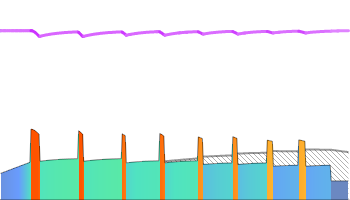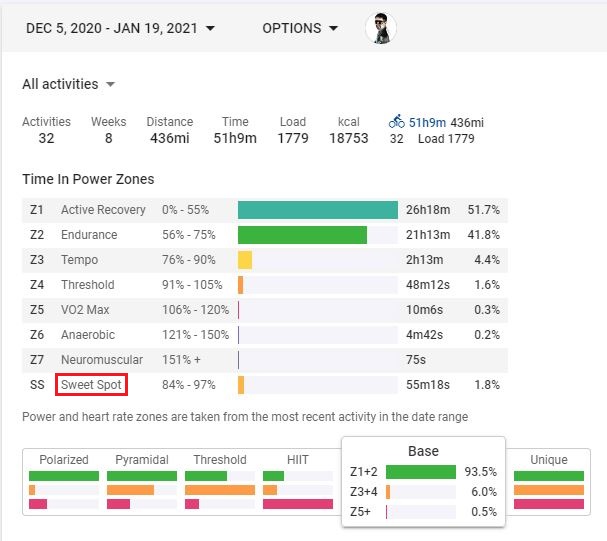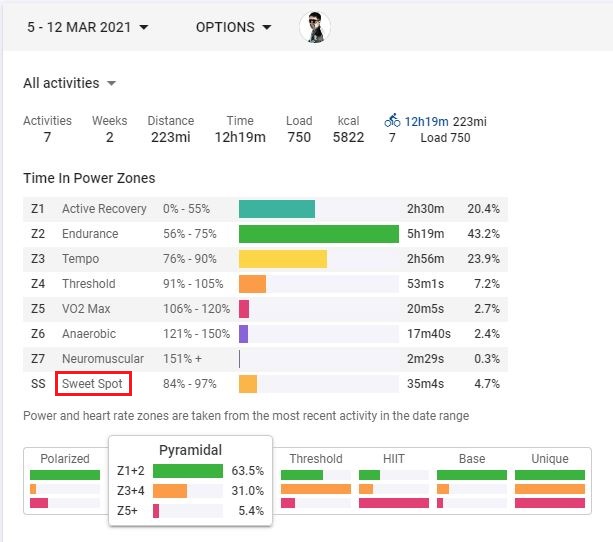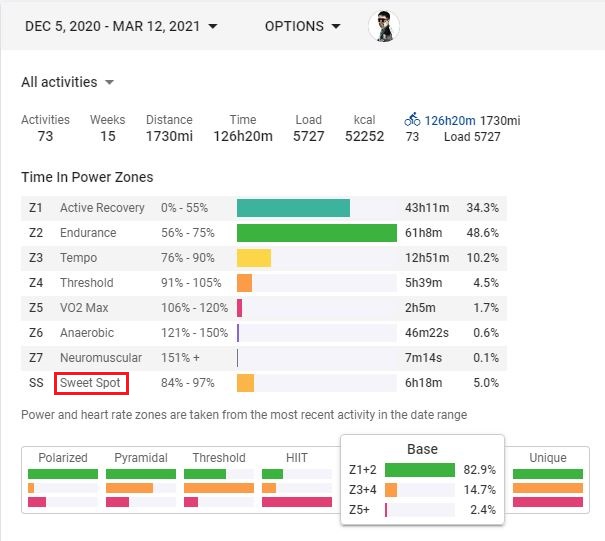I’ve studied the blog post on sweet spot vs. polarized and I think it’s really interesting. Personally, my LTP is 82% of TP. Therefore, sweet spot falls into “black hole” territory. That being the case, why is the planner recommending so many sweet spot sessions for me during the base phase for Athlete Types ranging from Sprint Time Trialist to Triathlete?
You’ll find our SST sessions to be a bit easier than others. We only have a small number. Our workouts generally avoid hard subthreshold intervals for base training workouts. Not exclusively though. There are still workouts that cover the entire range.
Hi, just blowing off some dust of this topic. I have a similar question:
The zone between LTP and TP has a green color in the workout designer/power analysis in Xert. After reading the blogpost about SST and the ‘black hole’ I thougt it might be a good idea to avoid workouts that show a lot of green. At least for indoor trainer workouts that is, as I find it difficult to avoid going in the green zone when riding outside. Is ‘avoiding the green’ a correct interpretation? Or is this a bit too strict, for example when it’s regarding a workout targeted at a shorter focus duration.
Second question: @xertedbrain says in the post above there are only a few workouts in the SST category. However I see quite a lot of workouts that show a lot of green. Does this depend on the fitness signature and could it be that for some people there are more SST workouts in the library than for others? As the blog points out SST based on %FTP could mean different things depending on fitness signature.
TL;DR – If you select from recommended workouts the “black hole” time accrued is too short to be considered true SST. Colored zones by fitness signature are the same for everyone but of course very different in wattage. Some riders’ green zone watts will be my red zone watts although the relative strain remains the same for each rider. 
SS is a portion of the green typically defined as 84-97% or 88-94% FTP but can range from 75-97% depending on the study referenced or the platform focused on SST. Most SST platforms use the same marketing tagline – “Get fast in less time” or “Get fast, fast”. 
With Xert’s hybrid POL/PYR approach (get fit, then fast) you don’t spend a lot of time hovering at SS during intervals. You pass through SS on the way to threshold and up, but you aren’t spending time at SS%'s doing 3x5’s, 2x20 or whatever.
There are only a few workouts in the Standard library that would be considered classic SS workouts. For comparison purpose here’s a more classic SS entry from the Coaches library –
(2) Xert - Workout Designer (xertonline.com)
You can look at things as either session based (by workout), weekly based (1-2 high intensity workouts and others low intensity), or consider your total hours spent for any time period. If you’re interested in doing that link Strava to intervals.icu and see how your historical activity is rated there. You can view ‘Totals’ for a date range or specific workouts and rides.
For example, here’s my stats from Dec 5 (start of Base) until today, riding strictly indoors, following recommended workouts. There is a little over 3 weeks left in Peak until my first TED (April 4) this year.
Base phase –
Build phase –
Peak phase (1 week so far, 3 to go) –
All phases to date –
YMWV based on Athlete type, IR setting, how often you adjust the FF slider, and how often you go off-list or ride outdoors.
IMO Xert’s Progression charts and activity details are all anyone really needs to get fit and analyze their data. ‘Totals’ is the only function I use at intervals.icu. I don’t delve into further details nor worry about 5-7 zone counts, etc., but find it interesting to review old-school splits on occasion. Those competing with specific goals in mind and concerned about marginal gains may have a different opinion. 
There is a focus duration shift in Xert as you move through phases ending with your selected Athlete type focus during Peak. If you are a well rounded cyclist (see spider chart form under Ranking) you may not notice much difference, but if weak in some areas those workouts will feel harder while in the green to yellow zones. You can use that knowledge when viewing chart snapshots in the recommended list to avoid the kind of workouts you don’t like. That’s what I do whenever the top choice isn’t agreeable. 
Reference:
Program Phases – Xert (baronbiosys.com)
Stress, Focus, Specificity and Strain – Xert (baronbiosys.com)
Thanks for sharing - have never religiously followed XATA through the phases myself
Are you happy to share how your focus has changed over time e.g. via screenshot of the focus progression chart and / or weekly stats by week? Would be good to illustrate the difference between workout focus when fresh (per XATA) and resulting weekly focus… given you’ll still be doing endurance quite a lot (when yellow, giving some polarisation) the weekly focus is actually longer than the recommended workout focus for the week
Covered here a while back for info
You do find green intervals in Xert workouts but the color is relative to your LTP (not TP) so depending on your signature they may fall above or below SS. We don’t generally design intervals at %TP such as 90% TP which is the classic SS interval.
We’ll often use green intervals after generating fatigue to boost XSS and create Hard Endurance workouts which are somewhat SST but we use fatigue just above LTP rather than keep you just below TP without fatigue. Different feel to them and most often the intervals are not 20 minutes. Bangarang for example is a Hard Endurance workout with green intervals and it’s one that I’d recommend if you’re into SST and have the fitness to complete. You’ll have a completely different appreciation for SST after doing it! It’s not one you’d do when status is yellow. Difficulty is too high.
So I guess avoiding the green is a bit of a stretch, as long as they are Xert/SMART workouts. For endurance rides outside I’ll try to keep below LTP. Thanks all for the replies!
Used to be a favorite, but just did it and must say the new approach to Smart intervals (fixed duration) makes those 1 minute efforts so much harder! They used to be XSSR based and you knew that you’d make it if you hold on, since power eases. Now I find the power increases through the interval (due to lag in ERG ramp up at the start of the interval - you never catch up) which means it’s an escalating power and XSSR… the final one went from 200 XSSR to over 300 which was crazy tough when fatigued! Have noticed similar in other workouts, and would be good if there were a way to choose… or some thought as to whether the time saving is material from going fixed duration (here I’d argue not - there aren’t many intervals… for micros I see the logic) or whether they should even be applied for what used to be XSSR based intervals (here I’d say the workout is worse)
Think I’ll make a copy and go back to the old style (constant XSSR and target MPA) next time, but maybe something for the Xert team to consider…?

I like the XSSR endurance under fatigue that get easier with time. Made several like this one for myself. Target time is % MPA for both on and off intervals and both XSS get a bit lower as the workout progresses and long term fatigue sets in. At least for me, I have no real endurance to speak of  I have them for 45min to 1.5h and like the feeling.
I have them for 45min to 1.5h and like the feeling.
And they are not really green, more turquoise I guess.
| Power | Duration | Rest-in-between Power | Rest-in-between Duration | Interval Count |
|---|---|---|---|---|
| 150 XSS per hour | 95% PP MPA | 75 XSS per hour | 99% PP MPA | 2 |
| 140 XSS per hour | 96% PP MPA | 70 XSS per hour | 99.2% PP MPA | 2 |
| 130 XSS per hour | 97% PP MPA | 65 XSS per hour | 99.4% PP MPA | 2 |
| 120 XSS per hour | 98% PP MPA | 60 XSS per hour | 99.6% PP MPA | 2 |



